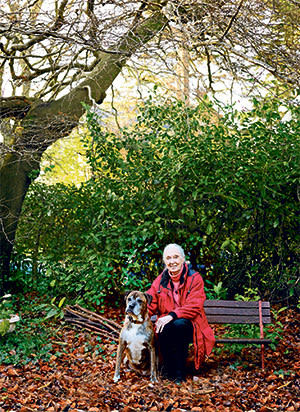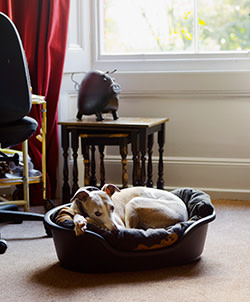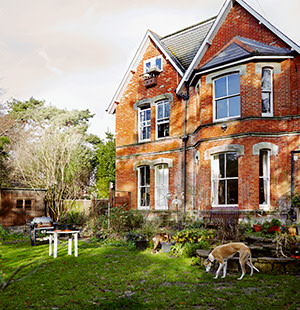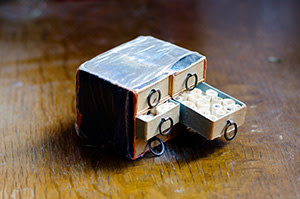Eco warrior Jane Goodall on the downward spiral of humanity

Simply sign up to the Life & Arts myFT Digest -- delivered directly to your inbox.
Jane Goodall points to the beech tree in her garden where she had her favourite roost as a child. “It’s grown too tall for me to reach the lower branches and climb it now,” she says ruefully. Yet it’s easy to imagine Goodall, straight-backed and slender at 79, swinging into its branches with the grace of the chimpanzees that she has given so much of her life in studying.
Goodall’s research into primates during the 1960s and 1970s transformed our perceptions of the relationships between humans and animals. Now she wants to change the way each of us thinks about our impact on planet Earth.
Goodall’s beech tree stands in front of an attractive 1872 townhouse in a secluded street a few minutes’ walk from Bournemouth beach. This has been the Goodall family home since 1939. “I’ve never left really,” says Goodall, three dogs at heel, as she welcomes me through the glazed front door into a large hallway. She has left, of course, and a full suitcase balanced on the wide staircase hints at a life on the move. As it happens, she has just flown in from Germany, the final leg of a gruelling three-month lecture tour. “I don’t know how I’m still alive,” she says.
Goodall is on the road for 300 days a year and has been for much of the past three decades. “But it’s good to be home and to have my own little space at the top.”
This is her base, but also home to other members of her tribe: her sister, her niece and two teenage great-nephews. A query about whether Goodall’s domestic arrangements are influenced by her understanding of our closest living relatives is met with short shrift: “Chimpanzees don’t even shelter from the rain!”
The dogs lead us into a sitting room packed with reminders of Goodall’s passion for the animal kingdom. A glass-fronted cabinet and a patterned period mantelpiece are home to a bestiary of model creatures – in wood, stone, plastic and glass – from all over the world. Three large beds for the dogs are prominent in the room: in order to sit down we must remove the wooden dog guards (an ingenious use for garden trellising) from the well-worn sofa. Next to the fireplace is a tank, teeming with small tropical fish, and on the other side is an aged, spiky lizard. His bright vivarium is the only artificial light to add to the weak winter sunshine that struggles in through sash windows at the far end of the long room.

Her creatures look happy in her sitting room, but Goodall is painfully aware of the environmental disharmonies elsewhere in the world.
Her eyes darken as she lists a gloomy catalogue of threats to animal life and ecosystems. Her concerns range from intensive farming, the spread of antibiotic resistance, vivisection and the development of GM crops, to the perils of explosive human population growth, our “selfish and materialistic” western values and the inexorable march of human-induced climate change.
“We are spiralling downwards – everything is interwoven,” she says. Goodall has devoted this phase of her life to doing something about it.
In 1988, she established the Jane Goodall Institute. First set up to help the world’s chimpanzees, increasingly threatened by poaching and the destruction of their habitats, the institute has since blossomed into an international charity with a broad remit for all kinds of environmental and educational work. It is co-ordinating these activities across 134 countries and spreading her message to audiences around the world that calls for such a relentless schedule.
As Goodall talks more about her work, the source of some of her enormous energy comes into focus. She sits forward in her chair as she explains about her youth and community programme, called Roots and Shoots. With more than 16,000 self-run and highly motivated groups, each with some 30 members, Goodall has already helped the best part of half a million young people to tackle problems in their local environments and communities. Plainly, Goodall is nourished by every successful Roots and Shoots activity: from litter clearing in British streams, to the successful campaign to de-popularise shark fin soup in China.
Grinning, she reaches for a strangely angular forest creature. “I’m not sure what it is,” she says, “but it was carved by a Batwa pygmy in Burundi.” The carving is an example of a different project that provides alternative income streams for a community of displaced hunters. “Every local action is an important piece in the global jigsaw puzzle.”

Yet even Goodall needs downtime and this house, full of memories and the ebb and flow of extended family life, is the place where it seems she can relax. She aims to reserve three weeks every year when she can retreat upstairs to write.
“I like playing with words and I can’t write anywhere else,” she says. These short, productive sessions have spawned multiple books in which she writes candidly.
Sadly, Goodall’s writing room is off-limits – “You can’t even really get through the door because of the stacks of books” – but there is a glimpse of this eyrie from the slightly overgrown garden: a small window up in the eaves, with bird feeders and nesting boxes.
We go back into the house via the kitchen. Between the high dresser, full of blue and white china, and the large Victorian fireplace, the space is dominated by a large, round table. A wooden chimpanzee looks down from the mantelpiece. Every surface is covered with the debris of daily life. Books, papers and unopened mail compete for space with dog food, cake tins and boxes teeming with insects to be fed to the lizard. This is a communal space where food is shared and stories exchanged. Indeed, every point Goodall makes is illustrated with a story of very human dimensions, and perhaps it is this ability to paint big, global issues in personal terms that makes people listen to Goodall.
Still, despite the success of her charity work, there are times when this indefatigable crusader struggles to stay optimistic for our future. “We are running out of time, but it’s my job to give people hope. Every single one of us makes a difference and has choices to make.”
——————————————-
Favourite things

Goodall’s favourite thing has family history – and even the power of prophesy. As a 12-year-old, she joined eight matchboxes together to make a stack of small drawers and filled them with dozens of handwritten scrolls; each slip of paper contains a quote from the Bible. Goodall made this Bible box as a gift for her grandmother and, for more than 50 years, the family have used it as an inspirational lottery.
The message Goodall produces is nothing if not appropriate in reminding her to push on with her life’s work: “He who has once set his hand to the plough and turneth back is not fit for the kingdom of heaven.”
Comments